Is It a Mistake or an Opportunity?
Last night, I spent a lot of time felting my traveling bag, and also a small "Red Hat Lady" handbag to put in the shop. Although the washer here in Forest City has hot water to it, I decided that the pressure was too low, the washer filling so slowly that the water would no longer be hot by the time the agitation cycle started, so I carried several canning kettles of water between the kitchen sink and the washing machine.
The little purse felted perfectly, although I noticed that stitching details on one part of the bag got lost in the felting process while still being visible elsewhere... not a big deal, really, just part of the random nature of felting.
It did get me thinking that felting really requires a large leap of faith... here you have devotedly knitted an object, maybe even taking a lot of time, like my traveling bag did. It perfectly matches your expectations, but now you are going to recklessly throw it into a hot water bath with uncertain outcome. I was using a wool I had felted before, but this time the red really bled quite a bit, maybe because the water temperature was hotter.
I was musing over the vagaries of felting, and admiring my little purse, while setting the dial back on the washer and wondering where in the house I would set everything to dry. The large rectangular pockets for my bag were now done, as were the handles... although in my mind they seem rather puny, considering the weight of a packed bag they are going to be asked to support.
The handles
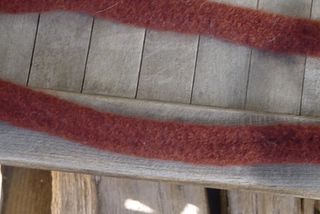
I pulled the large bag out of the washer and used the canner to carry it to the kitchen sink for a cool rinse. It had the right density, and I liked how the stripes had become blended in the felting process... so far, so good.
The bottom of the bag looks pretty darn near perfect.
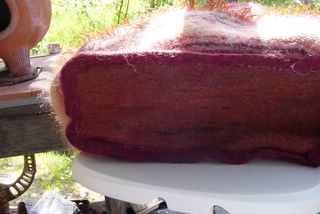
It wasn't till I started shaping it to dry that I discovered the problem. The pattern I had been following called for pockets to be sewn to each end, and had made the top flaps with ends attached, including buttonholes and cute little points, to fasten those pockets closed. Somehow, in the mass of creating those top flaps, I had gotten askew of that intention, and now those pieces were in entirely different locations.
The bag standing upright; I have two couch pillows stuffed inside a garbage bag giving it shape and substance while it dries.. and now you can see how far off I was in locating my so-called corners to attach the top closings.
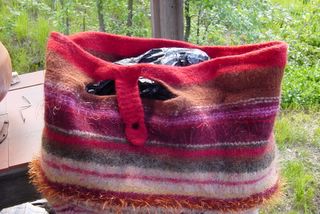
Notice, I am not calling this a mistake, but a problem... I looked at the bag, and thought to myself "Well, this is going to call for some creativity".
I have been creating and crafting my entire life, often with inadequate resources or materials different than those called for by another designer. I have often had to "think outside of the box" and still have come up with many creations I was supremely proud of... here I was, faced with the finality of felting something, and seeing that I was now going to have to alter my original conception of what I had created and redefine it.
I looked at those pockets, and thought about how they would just have a different overall appearance if positioned where they now seemed destined to go... but was that the only possibility? Did I want to put them on the inside instead, "hiding" my error? Or, did I want to accentuate the difference from the original? I am the kind to tend to opt for that method. I began thinking of using perle cotton to add accent sewing, both to stitch the pockets on and to stitch up and change the closure system. Maybe this was a good opportunity to strenghten the original design, making it reinforced in places to carry a big or bulky load.
I still need to let the various components dry completely, and install a zipper closure at the top, so went to bed near midnight, figuring there was more time to let the ideas percolate and a happy solution to float to the top.
This morning, over coffee, I read the following quote in an editorial in Yoga Journal: "If you get upset when the toast burns, what are you going to do when your house burns down?". Well, this quote epitomizes me in a nutshell... I have mostly been the person to only worry about the big stuff: one of my children getting injured, a friend dying of cancer, losing my job... these have been the real challenges of the past year, not whether I have to redesign my kintting project to have a happy outcome.
I am very grateful for this trait; it has served me well over the years. Somewhere back in the early stages of my mothering career, I read a lengthy poem about raising wee ones that ended with the lines that housework can wait. At my house, it is still waiting, even though all of the children are grown and most of them gone. It stays moderately clean and orderly around here, especially considering that we maintain two homes, fifteen miles and 2000 feet in elevation apart, but people ahave always been much more important. I did lots of things and went lots of places with my children while they were growing up, both while a single mom, and later when I married Glenn. In fact, I still spend a lot of great times and have marvelous adventures with them today.
I have been rewarded for this trait by children who grew to be wonderful, compassionate people that I take great joy in being around, by having dear friends and the admiration of colleagues, as well as the love of my husband, a kind man. I guess the old-timers would say I was one of those people who could turn a sow's ear into a silk purse.
I have also developed strong problem-solving skills over the years. So many things are out of our control, but sometimes, if we apply a little thought, we find ways to carry forward, fix things, make them better or come up with a new plan.
Once, over a decade ago, I spent an entire winter knitting a Shetland shawl out of fingering weight alpaca, following the plan laid out in the Mary Thomas Knitting Book.. I knew my knitting wasn't fine enough to pass through a wedding ring, but the finished product would be circular, with no seams. As I neared the end, I realized that I wasn't going to have enough yarn left for the border. I began looking through my stash and came up with two shades of blue wools, the right weight, and decided to use them to create the border... they contrasted very nicely with the natural medium brown of the alpaca, and when the shawl was folded in half to wear, one blue would fall on each half of the circle. This turned out to be a creative and acceptable solution, allowing me to finish this beautiful shawl.
Interestingly enough, as I pulled the shawl out of the cedar chest and stretched it out on the bed this morning, I noticed a few worn places where I had to tie threads together... perhaps they had caught on something when I wore it once, or perhaps an insect immune to cedar had taken a nibble ... it was a reminder to me that the perfection of completion is altered by time. Nothing ever stays the same, no matter how badly we might think we want it to.
Here is a picture of my Shetland shawl...while not the best photo, since it was taken at midday, you can see the stitch detail and colors ...

I also pulled a second shawl out of the cedar chest, planning to take both to the Black Sheep Gathering with me to wear (be honest, to show off). This shawl was knitted by Virginia Simmons,probably over fifty years ago, by a woman who passed away eleven years ago at the age of ninety. When I first moved to Forest City nineteen years ago, she was the town matriarch, having lived here since the 1940s and having acquired 11 structures, one of which I rented from her. We became friends as neighbors do, and her husband Joe gave me several of her things when she died. I have worn and treasured some, and saved others for the day when we can create an exhibit in her memory at our local museum.
This shawl was a feather and fan design, long and narrow, and made from pale pink zephyr with a thread of silver metallic running through it... dating it to the late 1940s. The color is no longer as clear, but there isn't a single moth hole in it, the knitting is very fine and defined, and the fringes on each end are delicately made. I have had it packed away and have never worn it; I was not the pink girl back then that I am today. I am looking forward to wearing this beautiful antique, because I believe that its life came from the knitter and I have the chance to honor her by continuing to use her creation.
Here is Virginia's Feather and Fan shawl.. the fringes are different from any I have ever seen before.. each fringe is actually a crocheted chain, looped back around and attached to the bottom of the work, then the next fringe is started from the next stitch over on the row. The photo doesn't do it justice... especially considering how many years it has lasted.
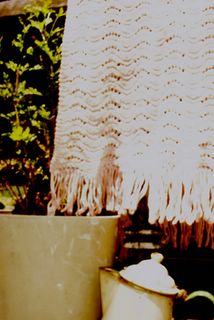
When the traveling bag is dry and assembled, you will get to see what I came up with this time.
The little purse felted perfectly, although I noticed that stitching details on one part of the bag got lost in the felting process while still being visible elsewhere... not a big deal, really, just part of the random nature of felting.
It did get me thinking that felting really requires a large leap of faith... here you have devotedly knitted an object, maybe even taking a lot of time, like my traveling bag did. It perfectly matches your expectations, but now you are going to recklessly throw it into a hot water bath with uncertain outcome. I was using a wool I had felted before, but this time the red really bled quite a bit, maybe because the water temperature was hotter.
I was musing over the vagaries of felting, and admiring my little purse, while setting the dial back on the washer and wondering where in the house I would set everything to dry. The large rectangular pockets for my bag were now done, as were the handles... although in my mind they seem rather puny, considering the weight of a packed bag they are going to be asked to support.
The handles


I pulled the large bag out of the washer and used the canner to carry it to the kitchen sink for a cool rinse. It had the right density, and I liked how the stripes had become blended in the felting process... so far, so good.
The bottom of the bag looks pretty darn near perfect.


It wasn't till I started shaping it to dry that I discovered the problem. The pattern I had been following called for pockets to be sewn to each end, and had made the top flaps with ends attached, including buttonholes and cute little points, to fasten those pockets closed. Somehow, in the mass of creating those top flaps, I had gotten askew of that intention, and now those pieces were in entirely different locations.
The bag standing upright; I have two couch pillows stuffed inside a garbage bag giving it shape and substance while it dries.. and now you can see how far off I was in locating my so-called corners to attach the top closings.


Notice, I am not calling this a mistake, but a problem... I looked at the bag, and thought to myself "Well, this is going to call for some creativity".
I have been creating and crafting my entire life, often with inadequate resources or materials different than those called for by another designer. I have often had to "think outside of the box" and still have come up with many creations I was supremely proud of... here I was, faced with the finality of felting something, and seeing that I was now going to have to alter my original conception of what I had created and redefine it.
I looked at those pockets, and thought about how they would just have a different overall appearance if positioned where they now seemed destined to go... but was that the only possibility? Did I want to put them on the inside instead, "hiding" my error? Or, did I want to accentuate the difference from the original? I am the kind to tend to opt for that method. I began thinking of using perle cotton to add accent sewing, both to stitch the pockets on and to stitch up and change the closure system. Maybe this was a good opportunity to strenghten the original design, making it reinforced in places to carry a big or bulky load.
I still need to let the various components dry completely, and install a zipper closure at the top, so went to bed near midnight, figuring there was more time to let the ideas percolate and a happy solution to float to the top.
This morning, over coffee, I read the following quote in an editorial in Yoga Journal: "If you get upset when the toast burns, what are you going to do when your house burns down?". Well, this quote epitomizes me in a nutshell... I have mostly been the person to only worry about the big stuff: one of my children getting injured, a friend dying of cancer, losing my job... these have been the real challenges of the past year, not whether I have to redesign my kintting project to have a happy outcome.
I am very grateful for this trait; it has served me well over the years. Somewhere back in the early stages of my mothering career, I read a lengthy poem about raising wee ones that ended with the lines that housework can wait. At my house, it is still waiting, even though all of the children are grown and most of them gone. It stays moderately clean and orderly around here, especially considering that we maintain two homes, fifteen miles and 2000 feet in elevation apart, but people ahave always been much more important. I did lots of things and went lots of places with my children while they were growing up, both while a single mom, and later when I married Glenn. In fact, I still spend a lot of great times and have marvelous adventures with them today.
I have been rewarded for this trait by children who grew to be wonderful, compassionate people that I take great joy in being around, by having dear friends and the admiration of colleagues, as well as the love of my husband, a kind man. I guess the old-timers would say I was one of those people who could turn a sow's ear into a silk purse.
I have also developed strong problem-solving skills over the years. So many things are out of our control, but sometimes, if we apply a little thought, we find ways to carry forward, fix things, make them better or come up with a new plan.
Once, over a decade ago, I spent an entire winter knitting a Shetland shawl out of fingering weight alpaca, following the plan laid out in the Mary Thomas Knitting Book.. I knew my knitting wasn't fine enough to pass through a wedding ring, but the finished product would be circular, with no seams. As I neared the end, I realized that I wasn't going to have enough yarn left for the border. I began looking through my stash and came up with two shades of blue wools, the right weight, and decided to use them to create the border... they contrasted very nicely with the natural medium brown of the alpaca, and when the shawl was folded in half to wear, one blue would fall on each half of the circle. This turned out to be a creative and acceptable solution, allowing me to finish this beautiful shawl.
Interestingly enough, as I pulled the shawl out of the cedar chest and stretched it out on the bed this morning, I noticed a few worn places where I had to tie threads together... perhaps they had caught on something when I wore it once, or perhaps an insect immune to cedar had taken a nibble ... it was a reminder to me that the perfection of completion is altered by time. Nothing ever stays the same, no matter how badly we might think we want it to.
Here is a picture of my Shetland shawl...while not the best photo, since it was taken at midday, you can see the stitch detail and colors ...


I also pulled a second shawl out of the cedar chest, planning to take both to the Black Sheep Gathering with me to wear (be honest, to show off). This shawl was knitted by Virginia Simmons,probably over fifty years ago, by a woman who passed away eleven years ago at the age of ninety. When I first moved to Forest City nineteen years ago, she was the town matriarch, having lived here since the 1940s and having acquired 11 structures, one of which I rented from her. We became friends as neighbors do, and her husband Joe gave me several of her things when she died. I have worn and treasured some, and saved others for the day when we can create an exhibit in her memory at our local museum.
This shawl was a feather and fan design, long and narrow, and made from pale pink zephyr with a thread of silver metallic running through it... dating it to the late 1940s. The color is no longer as clear, but there isn't a single moth hole in it, the knitting is very fine and defined, and the fringes on each end are delicately made. I have had it packed away and have never worn it; I was not the pink girl back then that I am today. I am looking forward to wearing this beautiful antique, because I believe that its life came from the knitter and I have the chance to honor her by continuing to use her creation.
Here is Virginia's Feather and Fan shawl.. the fringes are different from any I have ever seen before.. each fringe is actually a crocheted chain, looped back around and attached to the bottom of the work, then the next fringe is started from the next stitch over on the row. The photo doesn't do it justice... especially considering how many years it has lasted.


When the traveling bag is dry and assembled, you will get to see what I came up with this time.
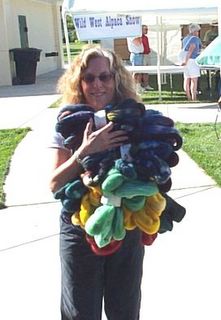












3 Comments:
What a bummer that you need to carry kettles of boiling water to the laundry.
The bag is looking really good so far. In craft we don't really have mistakes we just have challenges that impede our progress but being crafty we put our knowledge to good use.
The heirlooms look reeeeeeeeeally nice. I look on it as a priviledge to be entrusted with such works of art.
Keep on crafting.
Cathy
What lovely pictures you've posted for us.
Your bag is very attractive looking. You have an artists eye for things, so whatever you do to finish it will look great.
What a wonderful treasure!
Post a Comment
<< Home